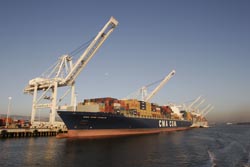
California
California Aquatic Invasive Species Management Plan

State surveys indicate that at least 607species of aquatic invaders can be found in California’s estuarine waters. These invaders cause major impacts: disrupting agriculture, shipping, water delivery, recreational and commercial fishing; undermining levees, docks and environmental restoration activities; impeding navigation and enjoyment of the state’s waterways; and damaging native habitats and the species that depend on them.
Read the California Aquatic Invasive Species Management Plan
Established Legislation
Assembly Bill 740 (AB 740)
This bill defines the term "vessel fouling", requires removal and recordkeeping of vessel fouling organisms from hull, piping, propellers, sea chests, and other submerged portions of one of those vessels at least every 60 months, and requires inwater cleaning of the submerged portion of a vessel while in the waters of the state to be conducted using specified procedures. Additionally, the bill requires the commission, by January 1, 2010, to develop and adopt regulations governing the management of vessel fouling on those vessels arriving at a California port or place, to protect the waters of the state.
Click here for an analysis of AB 740, courtesy of the California State Legislature.
Click here for the full bill language.
Senate Bill 497 (SB 497)
This bill requires the commission to adopt regulations on performance standards for ballast water or before January 1, 2008. For more information, see the SB 497 bill analysis by the California State Legislature.
Assembly Bill 433 (AB 433), California's Marine Invasive Spp. Act
AB 433 strenghtened the legislation begun by AB 703 (at bottom). AB 433 requires all vessels arriving from outside the EEZ and travelling between one port or place and another in the Pacific Coast Region to perform ballast exchange or certain qualifying vessels must retain all ballast water onboard. For more details, view the AB 433 Summary.
Assembly Bill 703 (AB 703)
Passed in October 1999, it required open ocean exchange or treatment for all vessels wanting to discharge ballast water in a California port after operating outside of the Exclusive Economic Zone (EEZ). AB 703 sunset in 2004 and was replaced by AB 433.
For more information see the California State Lands Commission website.